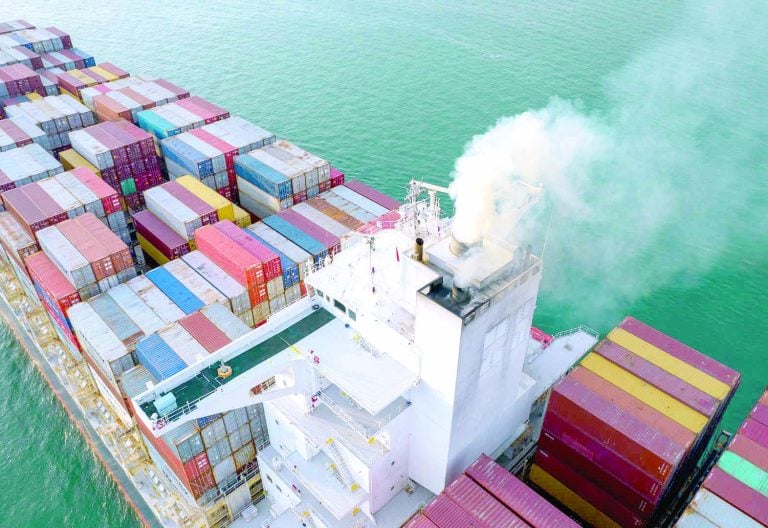Navigating a greenhouse gas levy on global shipping in climate action deal

There have been intensified calls for the imposing of carbon tax on global shipping to support climate change adaptation in vulnerable developing countries and to curb greenhouse gas emissions.
Shipping, which transports around 90 per cent of world trade, accounts for nearly 3 per cent of the world’s carbon dioxide emissions, a share expected to expand in the coming decades without tougher anti-pollution measures.
A group of 47 countries including Canada, the European Union, Japan and climate-vulnerable Pacific Island states have since March last year rallied support for a charge on the international shipping sector’s greenhouse gas (GHG) emissions.
The International Maritime Organisation (IMO), the United Nation’s maritime regulator, has been hosting meetings that outline four proposals with a combined backing of the 47 countries to impose a fee on each tonne of greenhouse gas the industry produces.
This week’s IMO talks in London are tasked with advancing a plan for putting a carbon price on global shipping emissions, according to Ralph Ragenvanu, Vanuatu’s special envoy for climate change and environment in a commentary in the UK-based Climate Home News.
“There are less than two months left for governments to deliver likely one of the biggest climate deals of the year – the world’s first universal emission price on a globally polluting sector – the international shipping industry,” says Ragenvanu.
In 2023, 176 IMO member states agreed on a historic target to transition to zero emissions by 2050, in a fair and equitable way.
“Pricing the sector’s billion tonnes of annual emissions, around 3 per cent of all global emissions, is the best way to deliver this critical commitment, while supporting the most climate-vulnerable countries, such as mine, in the process,” Ragenvanu argues.
Beneficial levy
The IMO interim discussions in London have the goal of finalising this important policy in April this year so that it can take effect in 2027.
Last month, there was a fresh wave of support for the future carbon price to be in the form of a levy, pushed by 49 countries in Africa, Asia, the Caribbean, Europe and across the Pacific, which only affirms the growing political momentum behind this evidence-based policy for shipping.
A strong carbon tax on shipping can give hope to climate-vulnerable communities, experts and campaigners assert. As the IMO is nearing a deal to price shipping emissions, many have argued that it should be in the form of a levy that benefits the Global South.
Last year in October, Maria Ogbugo, David Luke, Faten Aggad, Oluwasola Omoju and William Davis published a landmark report, ‘Navigating Action: Assessing the economic impacts and trade-offs of a shipping carbon tax for African states’, which examines the potential impact of a carbon levy on the African shipping industry.
The report highlights the economic challenges and opportunities it represents while advocating for equitable redistribution of revenues to support an inclusive transition to net-zero emissions.
“As the world grapples with the realities of climate change, the shipping industry has come into sharp focus as a catalyst for global climate action. The IMO, the entity responsible for regulating international shipping by at least 20 per cent, has committed to cutting emissions from shipping to net-zero by around 2050,” the report states.
Along the way, the IMO aims to reduce total annual GHG emissions from international shipping by at least 20 per cent, striving for 30 per cent, by 2030 (compared to 2008’s emissions) and by at least 70 per cent, striving for 80 percent, by 2040.
While some countries view the decarbonisation of the shipping industry as a chance to industrialise, for example by developing industry to supply green hydrogen as a maritime fuel, many states, including those with high ambitions, are concerned about the increasing cost of living and food security.
The report looks at some of the candidate mid-term measures under discussion at the IMO and the likely impacts they will have on African economies.
Significantly, the report recommends that the IMO adopts GHG reduction measures that allow for the redistribution of a significant portion of the revenues raised towards funding out-of-sector mitigation and resilience.
These funds can be used to develop projects in renewable energy, resilient agriculture and hydrogen production, all of which will contribute to the achievement of an equitable transition to net-zero emissions. These redistributions will help to smooth out the effects of the higher costs of doing business, with due regard to each country’s specific circumstances.
Key criteria for determining the revenues a country should receive include exposure to climate risk, economic context, access to climate finance and fiscal space, national income. Another determinant is the magnitude of disproportionate negative impacts that the measure will have on the economy as well as the country’s own contribution to GHG emissions.
All aboard
Finally, and perhaps most importantly, the report recommends that redistributions to countries should be in the form of direct transfers, not loans, if they are to truly reflect the principle of “polluter pays”.
Ragenvanu says that with most of the world’s biggest shipping powers, like Panama, Liberia, Greece and Japan, now firmly on board, the IMO has what it takes to make it a success. The next crucial step before April is to ensure that the design of the future policy- the price, scope and revenue distribution – is ambitious and fit for purpose.
A carbon levy, he says, would incentivise the clean energy transition in the shipping industry and provide the funding needed for it to be equitable. The World Bank estimates that around US$60 billion could be generated a year, based on a price of $100 per tonne of carbon dioxide equivalent (CO2e). The amount would be more with the US$150 campaigners are advocating for.
Adopting such a levy means that the IMO can succeed where decades of COP meetings have failed, translating realistic ambitions into binding measures.
“Last year gave us a terrifying preview of climate-change driven disruptions and destruction around the world, but especially in countries that already face the highest costs and burden of climate change,” recalls Ragenvanu, while adding that the IMO levy revenue could not come at a better time to help alleviate this pressure, provided that it is distributed strategically.
Global South countries, and particularly the most vulnerable ones, he says, could finance new technology and renewable energy production, as well as impose resilience to the climate change caused in no small part by international shipping.
Many of these countries, especially in Africa and Latin America, have immense renewable energy potential, which could supply the future zero-emissions energy for shipping while also addressing domestic clean electricity needs.
The world’s leading economists are clear that the clean transition in shipping will cost money no matter what, but that a levy is the best way to keep these costs as low as possible. Research commissioned by the IMO to assess the impact of measures proposed by member states draws the same conclusion.
“If we don’t act now, we will face a much higher bill down the line. Some estimate that climate inaction could cost around US$38 trillion in 2049, a bill that the Global South cannot – and should not – pick up,” warns Ragenvanu.
All eyes are on the IMO this week.











